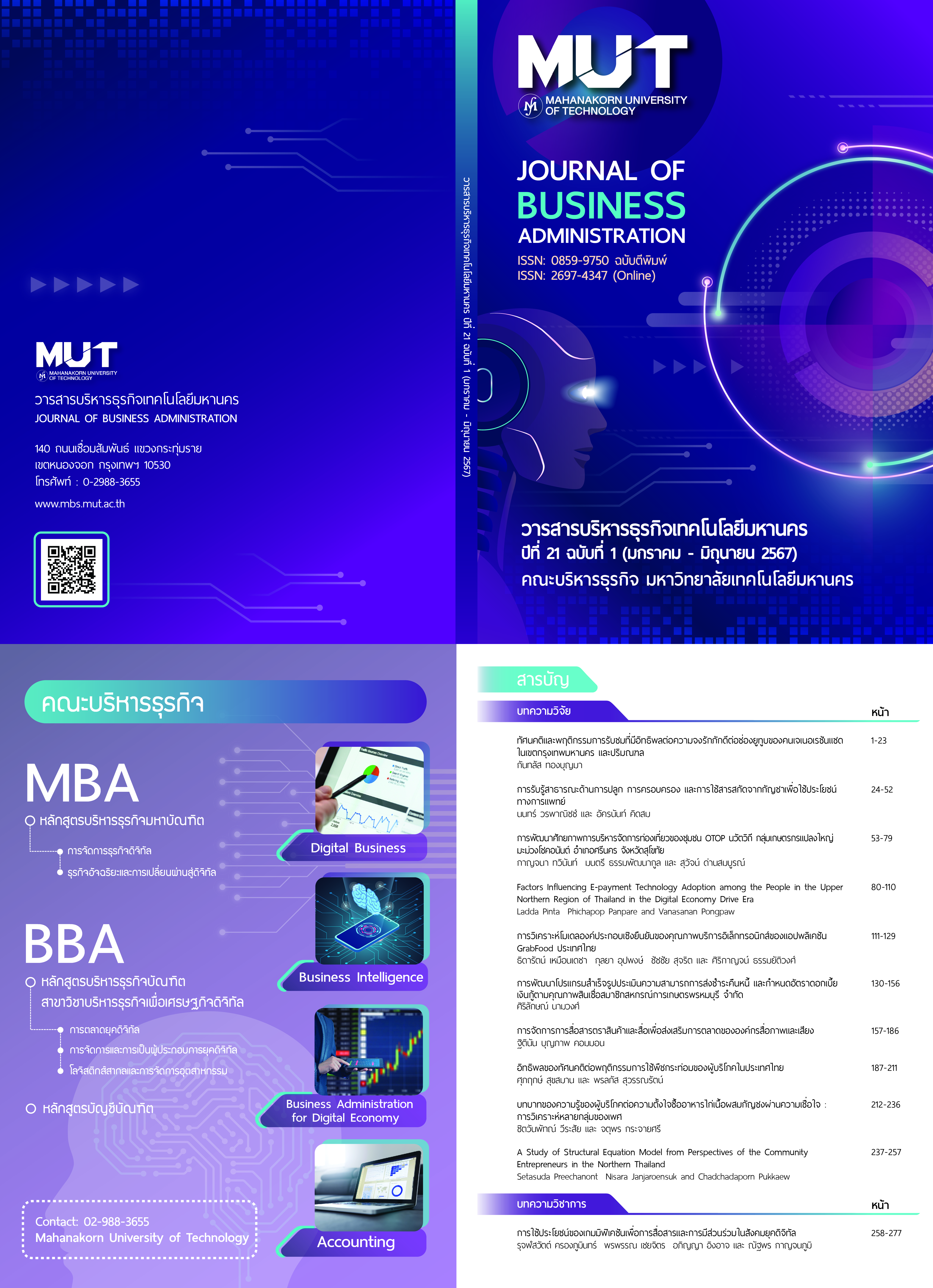Factors Influencing E-payment Technology Adoption among the People in the Upper Northern Region of Thailand in the Digital Economy Drive Era
Keywords:
Technology Adoption, Technology E-payment, Social Influence, Perceived Usefulness, Perceived Ease of Use, การรับรู้ความยากง่ายในการใช้งานAbstract
การวิจัยครั้งนี้มีวัตถุประสงค์เพื่อศึกษา ปัจจัยที่มีอิทธิพลต่อการยอมรับเทคโนโลยี E-payment ของประชาชนในเขตภาคเหนือตอนบน ในยุคการขับเคลื่อนเศรษฐกิจดิจิทัลในประเทศไทย โดยใช้การสุ่มตัวอย่างแบบแบ่งชั้น จำนวน 430 ราย เครื่องมือสำหรับการเก็บข้อมูล คือ แบบสอบถาม โดยแบ่งเป็น 4 ส่วน ประกอบด้วย สภาพทั่วไปของผู้ตอบแบบสอบถาม ปัจจัยที่มีอิทธิพลต่อการยอมรับเทคโนโลยี E-payment การยอมรับเทคโนโลยี E-payment และข้อเสนอแนะ ซึ่งมีความเหมาะสมกับการวิเคราะห์ข้อมูลด้วยการใช้เครื่องมือทางเทคนิคสถิติสมการ โครงสร้าง (SEM) โดยการวิเคราะห์เส้นทาง (Path analysis) ด้วยโปรแกรม SMARTPLS V.3.3.3
ผลการศึกษาชี้ให้เห็นว่า ปัจจัยสิ่งอำนวยสะดวก (FAS) มีอิทธิพลทางอ้อมสูงสุดโดยผ่าน ปัจจัยการรับรู้ความยากง่ายในการใช้งาน(PEOU) และปัจจัยการรับรู้ประโยชน์(PU) ข้อค้นพบจากการศึกษา ประชาชนในเขตภาคเหนือตอนบนมีการใช้งานอินเตอร์เพื่อการทำธุรกรรมทางการเงินให้ความสำคัญกับปัจจัยสิ่งอำนวยความสะดวก มากที่สุดเนื่องจากการใช้บริการ E-payment เป็นเรื่องใหม่สำหรับประชาชน การที่ประชาชนจะยอมรับและเริ่มต้นใช้งานเทคโนโลยี E-payment นั้นจำเป็นต้องอำนวยสะดวกและใช้งานง่าย
References
Agarwal, R. and Prasad, J. 1999. Are individual differences germane to the acceptance of new information technology? Decision Sciences. Vol. 30. 361 - 391.
Alkhowaiter, W.A. 2020. Digital payment and banking adoption research in Gulf countries: A systematic literature review. International Journal of Information Management. Vol. 53. No. 4. 102.
Athapaththu, J-C. and Kulathunga, D. 2018. Factors Affecting Online Purchase Intention: Effects of Technology and Social Commerce. International Business Research. Vol. 11. No. 10. 111.
Bank of Thailand. 2021. The Consumption of Plastic Cards for Payment. Retrieved December 23, 2023 from https://www.bot.or.th/App/BTWS_STAT/statistics/
BOTWEBSTAT.aspx?reportID=683andlanguage=TH
Ajzen, I. 1991. The theory of planned behavior. Organizational Behavior and Human Decision Processes. Vol. 50 No. 2. 179 – 211.
Alswaigh, Y. N. and Aloud, E. M. 2021. Factors Affecting User Adoption of E-Payment Services Available in Mobile Wallets in Saudi Arabia. International Journal of Computer Science and Network Security. Vol. 21. No. 6. 222 - 230.
Beauchamp, M.R., Brayb, S.R., Fieldingc, A. Eysd, M.A. 2005. A multilevel investigation of the relationship between role ambiguity and role efficacy in sport. Group Dynamics Theory Research and Practice. Vol. 6. No. 3. 229 - 242.
Becker, J-M., Klein, K. and Wetzels, M. 2012. Hierarchical Latent Variable Models in PLS-SEM: Guidelines for Using Reflective-Formative Type Models. Long Range Planning. Vol. 45. No. 5 – 6. 359 – 394.
Carmeli, A., Meitar, R. and Weisberg, J. 2006. Self-leadership skills and innovative behavior. International Journal of Manpower. Vol. 27. No. 1. 75 - 90.
Chawla, D. and Joshi, H. 2017. Consumer perspectives about mobile banking adoption in India – a cluster analysis. International Journal of Bank Marketing. Vol. 35. 616 – 636.
Choudhary, S., Mutava, R.N., Shekoofa, A., Sinclair, T.R. and Vara Prasad, P.V. 2013. Is the Stay-Green Trait in Sorghum a Result of Transpiration Sensitivity to Either Soil Drying or Vapor Pressure Deficit? Crop Science. Vol. 53. No. 5.
Davis Jr, F. D. 1986. A technology acceptance model for empirically testing
new end-user information systems: Theory and results. Doctoral dissertation. Massachusetts Institute of Technology.
Davis, F. D., Bagozzi, R. P. and Warshaw, P. R. 1989. User acceptance of computer technology: a comparison of two theoretical models. Management science. Vol. 35. No. 8. 982 - 1003.
DeLone, W. H. and McLean, E. R. 2003. The DeLone and McLean Modelof Information system success: A Ten-Year Update. Journal of Management information System. Vol. 19. No. 4. 9 – 30. M.E. Sharpe, Inc.
Dishaw, M.T. and Strong, D.M. 2019 1999. Extending the Technology Acceptance Model with Task-technology Fit Constructs. Information and Management. Vol. 36. 9 - 21.
Gaitán, J. A., Peral, B. P. and Jerónimo, M. A. R. 2015. Elderly and internet banking: an application of UTAUT2. Journal of Internet Banking and Commerce. Vol. 20. No. 1. 1 – 23.
Gefen, D. and Straub, D. 2000. The Relative Importance of Perceived Ease of Use in IS Adoption a Study of E-Commerce Adoption. Journal of the Association for Information Systems. Vol. 1. 1 - 28.
Guo, H., Huang, X. and Craig, P. 2015. Factors Influencing the User Acceptance of Alipay. International Conference on Economy, Management and Education Technology (ICEMET 2015) 344 - 347. Published by Atlantis Press.
Hair, J. F., Sarstedt, M., Hopkins, L. and Kuppelwieser, V. G. 2014. Partial Least Squares Structural Equation Modeling (PLS-SEM): An Emerging Tool in Business Research. European Business Review. Vol. 26. No. 2. 106 - 121.
Hair, J. F., Sarstedt, M., Pieper, T. M. and Ringle, C. M. 2012. The Use of Partial Least Squares Structural Equation Modeling in Strategic Management Research: A Review of Past Practices and Recommendations for Future Applications. Long Range Planning. Vol. 45. 320 - 340.
Hamner, M. and Qazi, R-ur-R. 2009. Expanding the Technology Acceptance Model to examine Personal Computing Technology utilization in government agencies in developing countries. Government Information Quarterly. Vol. 26. No. 1. 128 - 136.
Haryono, S. and Brahmana, R.K.M.R. 2015. The Effect of Shopping Orientation, Social Influence, and System on Customer Attitude through Perceived Ease of Use (Study at Apple Store). Journal Management Pemasaran Petra. Vol. 3. No. 1. 1 - 10.
Henseler, J., Ringle, C.M. and Sarstedt, M. 2015. A New Criterion for Assessing Discriminant Validity in Variance-based Structural Equation Modeling. Journal of the Academy of Marketing Science. Vol. 43. No. 1. 115 - 135.
Henseler, J., Ringle, C.M. and Sinkovics, R.R. 2009. The use of partial least squares path modeling in international marketing, Sinkovics, R.R. and Ghauri, P.N. (Ed.) New Challenges to International Marketing. Advances in International Marketing. Vol. 20. Emerald Group Publishing Limited. Bingley. 277 - 319. Retrieved September 24, 2022 from https://doi.org/10.1108/S1474-7979(2009)0000020014
Hu, L.-t., and Bentler, P. M. 1998. Fit indices in covariance structure modeling: Sensitivity to underparameterized model misspecification. Psychological Methods. Vol. 3. No. 4. 424 – 453. Retrieved September 24, 2022 from https://doi.org/10.1037/1082-989X.3.4.424
Jhantasana, C. 2020. Methods of Reporting Research Results of Second-order Construct of PLS-SEM. Chulalongkorn Business Review. Vol. 42. No. 3. 39 - 67.
Joo, Baek-Kyoo, Yoon, Hea Jun and Jeung, Chang-Wook. 2012. The Effects of Core Self -Evaluations and Transformational Leadership on Organizational Commitment. Leadership and Organization Development Journal. Vol. 33. No. 6. 564 - 582.
Kaewtan, J. 2014. Factors Influencing the Acceptance of Electronic Payment Using Smart Phone Devices: in case of Bangkok and Pathum Thani. Independent Study. Master of Business Administration. Faculty of Business Administration. Rajamangala University of Technology Thanyaburi.
Kasikorn Research Center. 2021. Business Trend Analysis, B2C E-commerce Product Group in 2021 Grew more than 30%. Entrepreneurs Encounter the Problem of Purchasing Power and Intensive Competition. Issue No. 3268.
Kim, C., Tao, W., Shin, N. and Kim, K.-S. 2010. An empirical study of customers’ perceptions of security and trust in E-payment systems. Electronic Commerce Research and Applications. Vol. 9 . No. 1. 84 - 95.
Kline, R.B. 2011. Principles and Practice of Structural Equation Modeling. Guilford Press, New York.
Kock, N. 2017. Factor-based SEM building on consistent PLS: An information systems illustration. Laredo. TX: ScriptWarp Systems.
Kongpalee, T. 2020. Is Thai Society (going to) Cashless?. Focus and Quick: FAQ. No. 169. Bank of Thailand.
Iacobucci, D. 2010. Structural Equation Modeling: Fit Indices, Sample Size and Advanced Topics. Journal of Consumer Psychology. Vol. 20. 90 - 98.
Lauro, C. and Vinzi, V.E. 2004. Some contribution of PLS path modeling and a system for the European customer satisfaction. Dipartimento di Matematica e Statistica. Universita Federico II di Napoli. 201 - 210. Retrieved September 28, 2022 from http://tinyurl.com/k2fgqa9
Lin, J., Xiao, S. and Cao, Y. 2010. Predicting and Explaining the Adoption of Mobile Banking. Proceedings of Annual Conference of China Institute of Communications. Scientific Research. 421 - 424. Retrieved June 18, 2019 from http://file.scirp.org/pdf/6-4.15.pdf
Lu, J. 2014. Are personal innovativeness and social influence critical to continue with mobile commerce?. Internet Research. Vol. 24. No. 2. 134 - 159.
Manzano, J.A., Ruiz, C. and Blas, S.S. 2009. Exploring individual personality factors as drivers of M-shopping acceptance. June 2009. Industrial Management and Data Systems. Vol. 109. No. 6. 739 - 757.
Mohan, S. 2014. Consumer’s acceptance towards NFC mobile payments. Master Thesis. University of Amsterdam.
Muangling, S. 2015. Factors Affecting Consumer Confidence in Mobile Banking in the Bangkok Metropolitan Area. Independent Study, Master of Business Administration. Faculty of Commerce and Accountancy. Thammasat University.
Musyaffi, A. M., Sari, D. A. P. and Respati, D. K. 2021. Understanding of Digital Payment Usage During COVID19 Pandemic: A Study of UTAUT Extension Model in Indonesia. The Journal of Asian Finance, Economics and Business. Vol. 8. No. 6. 475 - 482.
Najdawi, A., Chabani, Z. and Said, R. 2015. Factors Impacting Digital Payment Adoption: An Empirical Evidence from Smart City of Dubai. Advances in Science, Technology and Engineering Systems Journal. Vol. 6. No. 1. 1208 - 1214. ASTESJ ISSN: 2415-6698.
Office of Strategy and Information for Habitat. 2023. Population and Housing Information Report 2022. Pages 15 - 19. Retrieved February 24, 2023 from https://housingkc.nha.co.th/files/article/attachments/aed52b2717f2d051d449844fc4f1ddc6.pdf
Phiriyakul, M. 2010. Some of the Least Squared Path Models. The 11th Academic Conference on Statistics and Applied Statistics, 2010.
Ringle et al., 2015. A New Criterion for Assessing Discriminant Validity in Variance-based Structural Equation Modeling. Journal of the Academy of Marketing Science. Vol. 43. No. 1. 115 - 135.
Riskinanto, A., Kelana, B. and Hilmawan, D. R. 2017. The Moderation Effect of Age on Adopting E-payment Technology. Procedia Computer Science. Vol. 124. 536 – 543.
Roca, C.J., Garcia, J.J. and José de la Vega, J. 2009.. The importance of perceived trust, security and privacy in online trading systems. Information Management & Computer Security. Vol. 17. No. 2. 96 - 113.
Rogers, E. M. 2003. Diffusion of innovations. 5th edition. New York: The Free Press.
Sarstedt, M., Ringle, C.M., Smith, M. and Reams, R. 2014. Partial Least Squares Structural Equation Modeling (PLS-SEM): A Useful Tool for Family Business Researchers. Journal of Family Business Strategy. Vol. 5. No. 1. 105 - 115.
Singh, N. and Sinha, N. 2020. How perceived trust mediates merchant’s intention to use a mobile wallet technology. Journal of Retailing and Consumer Services. Vol. 52. No. March.
Tan, H., and Brahmana, R.K.M.R. 2019. The Effect of Perceived Value on Repurchase Intention Through Customer Satisfaction as Intervening Variables in Shopee. AGORA. Vol. 7. No. 1. 1 - 7.
Taylor, S. and Todd, P. 1995. Assessing IT usage: The role of prior experience. MIS quarterly. Vol. 19. No. 4. 561 - 570.
Teo, T. S. H., Lim, V. K. G. and Lai, R.Y.C. 1999. Intrinsic and extrinsic motivation in internet usage. The International Journal of Management Science. Vol. 27. No. 1. 25 - 37.
Thaicharoen, Y. 2020. Executive Vice President of Economic and Business Research Center, Siam Commercial Bank Thailand after COVID-19 Part 2: Business Opportunity and Survival.
Tonghui, T., Kongpalee, T. and Chimnoi, A. 2020. Aiming for a Cashless Economy: Consumer Behavior and Opportunities of Thai businesses during COVID 19. Retrieved October 4, 2023 from https://www.bot.or.th/Thai/Researchand Publications/articles/Pages/Article_21Jul2020.asp
Tripathi, P. 2014. Effects of Brand Endorsements by Opinion Leaders on Rural Consumer Buying Behavior. International Journal of Multidisciplinary Approach and Studies. Vol. 1. No. 4. 226 - 235.
Udomvejsakul, S. 2014. Factors Influencing Confidence in Using M-Banking Application. Master's thesis. Thammasat University. Faculty of Commerce and Accountancy.
Venkatesh, V., Morris, M. G., Davis, G. B., and Davis, F. D. 2003. User acceptance of information technology: Toward a unified view. MIS quarterly. Vol 27. No. 3. 425 - 478.
Vianello, M., Galliania, E. M. and Haidtb, J. 2010. Elevation at Work: The Effects of Leaders’ Moral Excellence. The Journal of Positive Psychology. Vol. 5. No. 5. 390 – 411.
Wen, Y., Parrish, J.Z., He, R., Zhai, R.G. and Kim, M.D. 2011. An Integrated Model for Customer Online Repurchase Intention. Journal of Computer Information Systems. Vol. 48. No. 1. 1 – 8.
West, S. G., Finch, J.F. and Curran, P.J. 1995. Structural equation models with nonnormal variables: Problems and remedies. In R. H. Hoyle (Ed.). Structural equation modeling: Concepts, issues, and applications. 56 – 75. Sage Publications, Inc.
Westland, J.C. 2010. Lower Bounds on Sample Size in Structural Equation Modeling. Electronic Commerce Research and Applications. Vol. 9. No. 6. 476 – 487.
Additional Files
Published
Issue
Section
License

This work is licensed under a Creative Commons Attribution-NonCommercial-NoDerivatives 4.0 International License.
ข้อความ ข้อคิดเห็น ข้อมูล เนื้อหา รูปภาพ แผนภูมิ แผนผัง เป็นต้น ที่ปรากฏและแสดงในบทความต่างๆ ในวารสารบริหารธุรกิจเทคโนโลยีมหานคร ถือเป็นความรับผิดชอบโดยตรงของผู้เขียนบทความนั้นๆ มิใช่เป็นความรับผิดชอบใดๆ ของวารสารบริหารธุรกิจเทคโนโลยีมหานคร และมหาวิทยาลัยเทคโนโลยีมหานคร
บทความที่ตีพิมพ์ในวารสารบริหารธุรกิจเทคโนโลยีมหานคร ถือเป็นลิขสิทธิ์เฉพาะของคณะบริหารธุรกิจ มหาวิทยาลัยเทคโนโลยีมหานคร หากบุคคลหรือหน่วยงานใดต้องการนำทั้งหมดหรือส่วนใดส่วนหนึ่งไปเผยแพร่ต่อหรือเพื่อกระทำการใดๆ จะต้องได้รับการอนุญาตเป็นลายลักษณ์อักษรจากคณะบริหารธุรกิจ มหาวิทยาลัยเทคโนโลยีมหานครก่อนเท่านั้น


